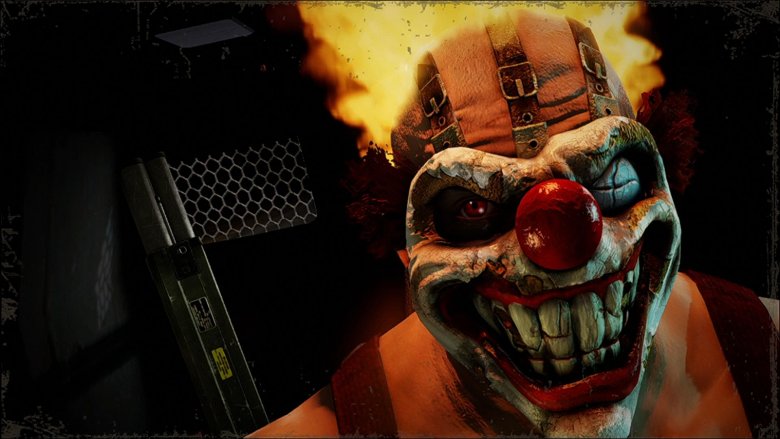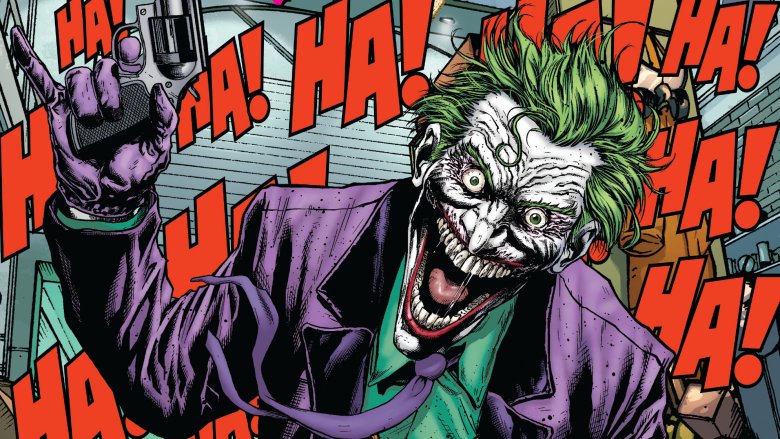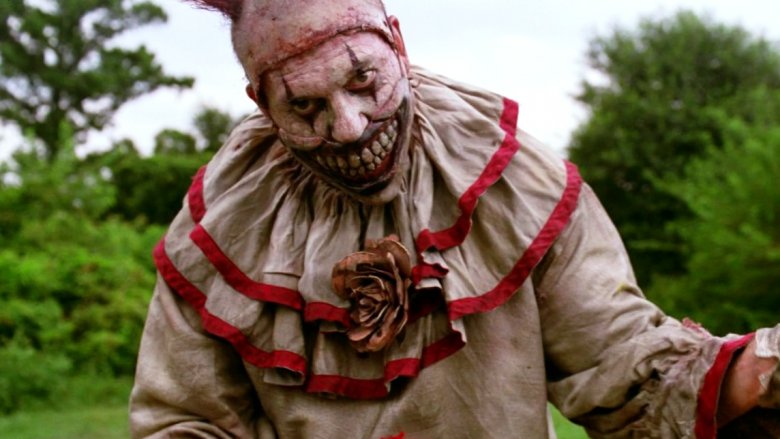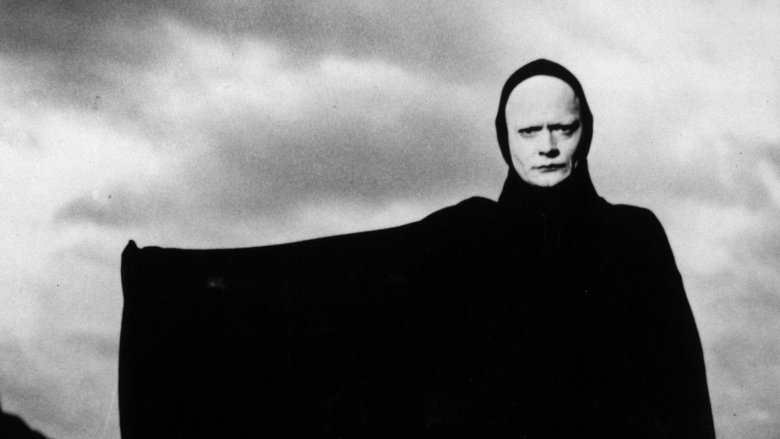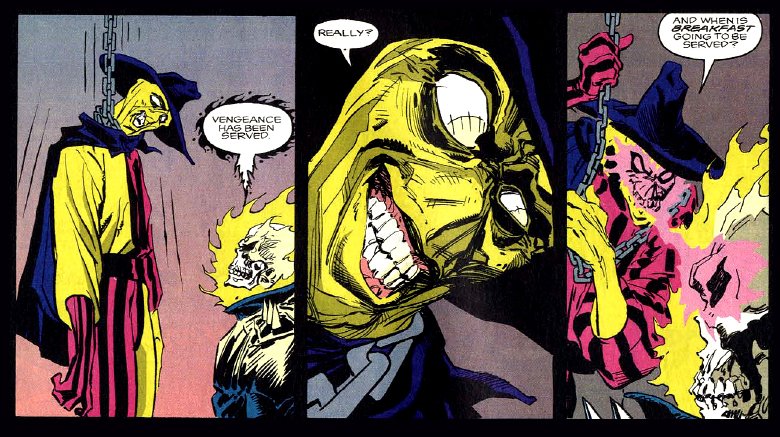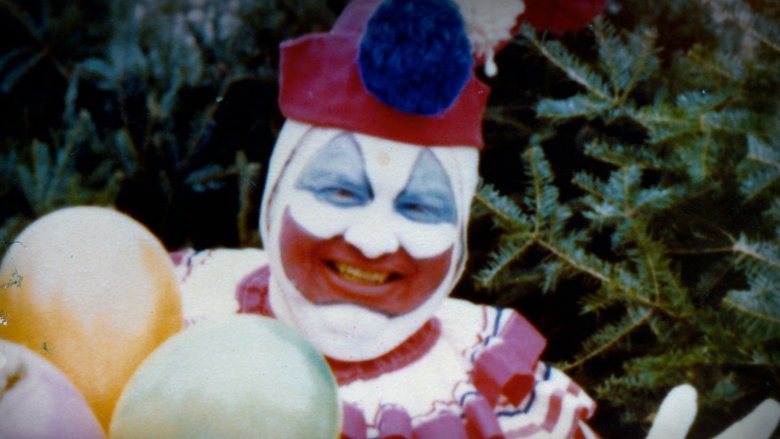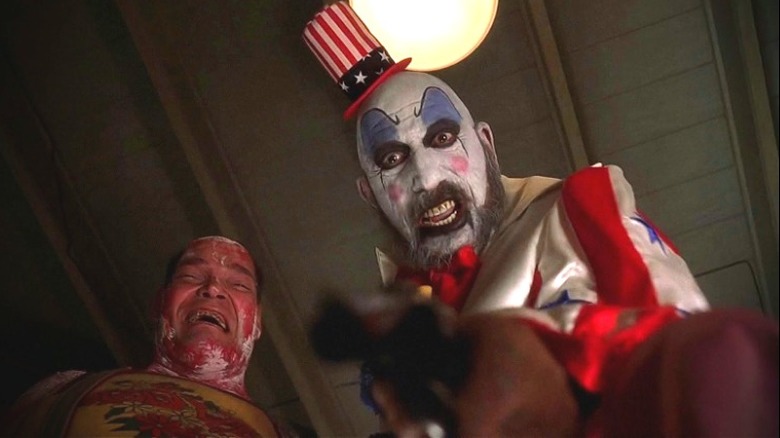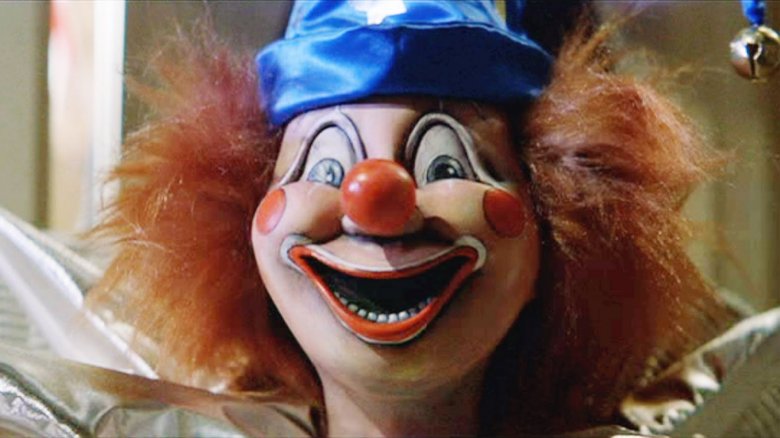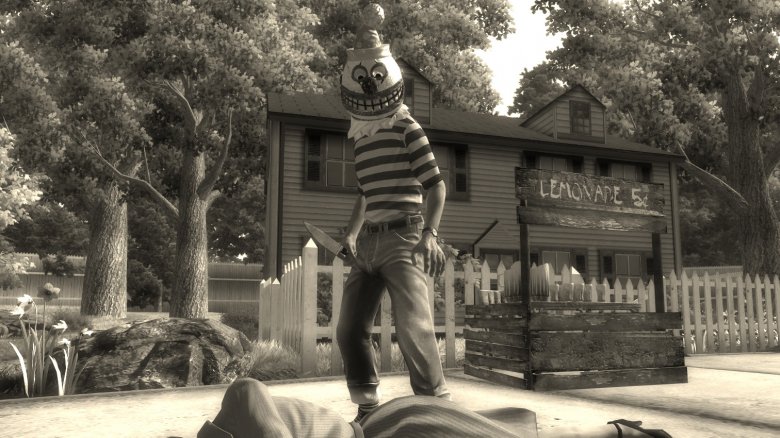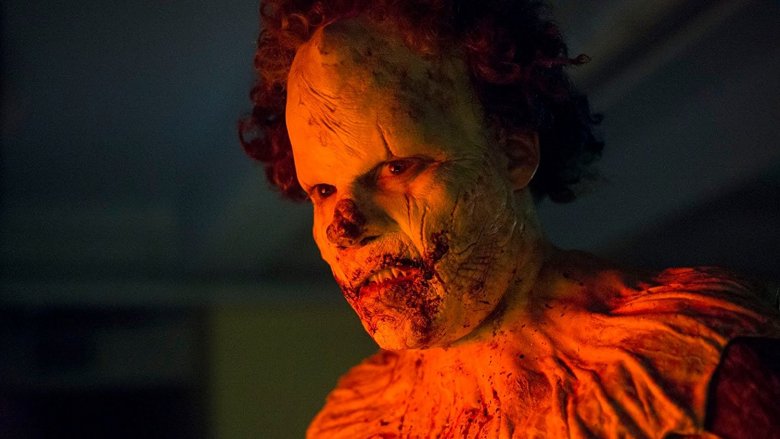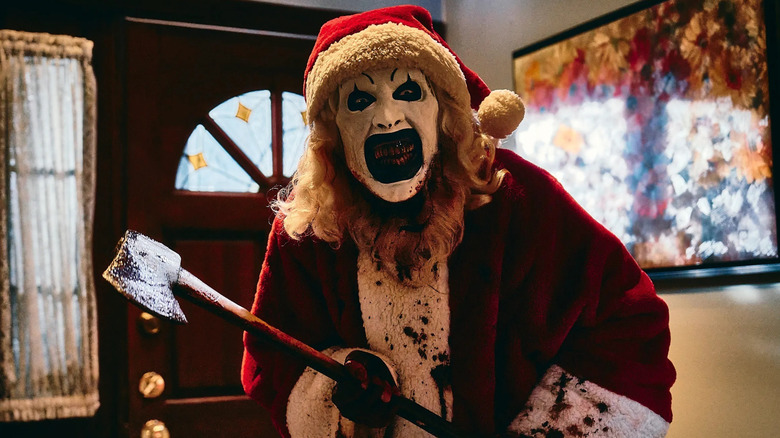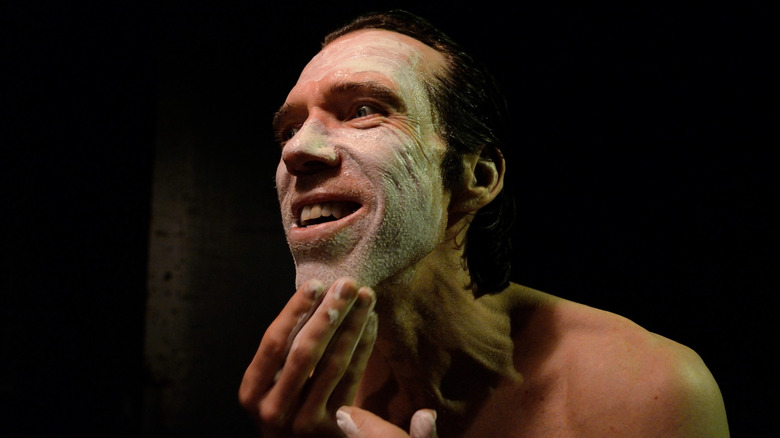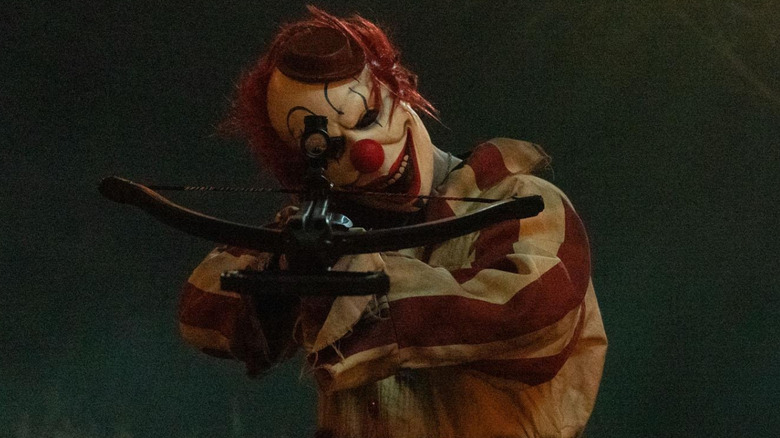These Clowns Are More Terrifying Than Pennywise
Some say that Stephen King's "It" made kids afraid of clowns, but they were terrifying people long before Pennywise came along. In fact, the evil clown as an archetype has a reach that's much wider than "It's" particular story of an extra-dimensional monster who takes on the shape of a clown as it haunts a small Maine town.
And even though Pennywise brags about being everything you're afraid of, some clowns may even be scarier than him. After all, a murderous human whose motivations make no sense can be scarier than an abstract Lovecraftian terror, and even if you do stay within the realm of the supernatural, there are more frightening ideas. So with that in mind, here are over a dozen other clowns guaranteed to give you nightmares.
Needles Kane
Needles Kane is a clown. A serial killer clown, specifically, who drives an armed-to-the-teeth ice cream truck called Sweet Tooth in an apocalyptic demolition derby. He's been driving that truck since the first "Twisted Metal" game in 1995, and he's only gotten creepier with each new version. In the original game, he was a pretty standard killer clown with green hair. In 1996, "Twisted Metal 2: World Tour" introduced the idea that his head was perpetually on fire, although no reason was given. In 2001, "Twisted Metal: Black," the fifth game in the series, revealed that just as he was about to be executed, he was cursed by a preacher to burn forever in the fires of Hell. Though he managed to escape the execution, he carries the fires of Hell around with him. That's just creepy.
The 2012 version of "Twisted Metal" gives Needles Kane a fuller backstory. He was an ice cream man with a family and seemingly happy domestic life, but he had a deeply buried resentment of the mundanity of his existence, which grew into a chaotic and evil second personality. Eventually that side of him took over, and he donned the clown mask, hellfire bursting from his head as he did so, and murdered his family. His daughter, however, escaped, so he spent years trying to find her and finish the job, killing many other people along the way.
The Joker
As one of DC Comics' premier villains, the Joker is a force of pure chaos, which is why he's the greatest enemy of Batman, whose purpose is to maintain order. He's had various origin stories over the years, but while they tend to involve falling into a vat of chemicals while trying to escape Batman, who he was before that is up in the air.
In his original origin, he was already a supervillain known as the Red Hood. In the influential "Batman: The Killing Joke" graphic novel by Alan Moore and Brian Bolland, he was a young, aspiring comedian who had only turned to crime to support his pregnant wife, who was killed in a freak accident that same day. But even within that book, this sympathetic backstory is called into question, with the Joker saying that he prefers his past to be "multiple choice." In Tim Burton's "Batman," he's a hardened criminal named Jack Napier (Jack Nicholson), and in Christopher Nolan's "The Dark Knight," the chemical origin is abandoned entirely in favor of a Joker (Heath Ledger) with a Glasgow smile and multiple stories of how he got it.
This lack of a definitive origin — or even a clear identity — is key to the nature of the Joker. He's dedicated to the idea that the world makes no sense and is particularly obsessed with proving that premise to Batman. He will murder, maim, and mutilate anyone who crosses his path, not just for no reason, but to illustrate that there are no reasons. He's not just a mad clown; he's a clown that embodies madness.
Twisty
Few clowns have ever been as visually frightening as Twisty, the deranged killer featured in "Freak Show," the fourth season of Ryan Murphy's FX anthology series, "American Horror Story." In fact, Murphy has said that members of the crew would leave when they were filming Twisty's scenes because he was so frightening. Over the course of the season, his backstory is revealed, but at no point does he get less terrifying.
Twisty was once a circus clown who loved to entertain children, but his career was ruined by false rumors of pedophilia. He then attempted a new career as a toymaker but failed at that as well. He then failed at committing suicide with a shotgun, succeeding only in blowing off his lower jaw. That's why he's wearing the half-mask with the terrifying smile — but what's underneath it is even more horrific.
Leaving reality entirely behind, Twisty begins kidnapping children in a supposed effort to save them from their oppressive parents. He's convinced children still love him and long to be entertained by his twisted antics, even though every child (and every adult) who sees him screams and runs away as if their lives were in the balance — which, of course, they are.
Death
What clown could be scarier than Death itself? In his influential film "The Seventh Seal," Swedish director Ingmar Bergman styled Death (Bengt Ekerot) as a mirthless, white-faced clown. The sort of European clown he was building on is different from the colorful version we're used to, something more akin to a mime. As Bergman explained, "white clowns have a multiple, ambiguous symbolism: they are beautiful, cruel, dangerous, balancing on the border between death and destructive sexuality."
Regardless of whether you agree with Bergman about the destructive sexuality of clowns, there's no denying that his film, in which a medieval knight plays chess with death, revolutionized pop culture portrayals of Death. Just look at "Bill and Ted's Bogus Journey," where William Sadler plays a Death who is "virtually identical" to the "Seventh Seal" version.
Death, in Bergman's vision, is a figure who cannot be reasoned with, cannot be persuaded or won over. But he will play games with you if you're willing to take the risk. When you think about it, that is clownlike, not to mention creepy on a whole different level from the monsters and maniacs that make up most of this list.
Madcap
Madcap is a Marvel supervillain, technically, but he's so chaotic that it's hard to judge his actions by the usual supervillain standards. He first appeared in "Captain America" #307, by Mark Gruenwald and Paul Neary, but unlike most villains, he never felt restricted to tormenting one hero or team in particular. In fact, aside form the time he literally become a second mind inside of Deadpool's body, he doesn't seem to care much about superheroes at all — until they get in the way of his goal of spreading chaos wherever he goes.
Madcap has two superpowers, and though they seem unrelated, they combine to make him a truly terrifying figure. First, he can't be hurt or killed. Any injury he suffers heals almost instantly, and if he dies, he immediately resurrects. If you cut his arms off, they'll rejoin his body (and he somehow keeps moving them in the meantime). Second, he can make other people behave irrationally simply by making eye contact with them. Basically, anyone he infects with this power begins behaving just as chaotically as he does. But since they don't receive his invulnerability, they're putting themselves in danger, dancing through traffic or leaping off of buildings.
A clown who will kill you is scary, but a clown who makes you lose your mind so you kill yourself is even scarier.
John Wayne Gacy
Look at this photo of Pogo the Clown. At first glance, to anyone who's not a clown or an expert on clowns, he looks pretty standard. But notice the red around his mouth and the way it comes to sharp points. If you compare that to most clowns (not the ones on this list), you'll see that's just not normal. Standard clown practice is to use rounded corners because it looks less frightening to kids. Pogo probably wasn't trying to look creepy, but that little detail feels significant because he might be the creepiest real clown to ever live.
As you probably know by now, Pogo the Clown was the alter ego of John Wayne Gacy, a notorious serial killer who murdered at least 33 young men and boys in the 1970s before he was eventually executed for his crimes. With all the real death and pain Gacy caused, it would be in poor taste to recount his crimes on a light-hearted list like this, but no rundown of terrifying clowns would be complete without Gacy, because no fictional killer clown can be scarier than one who really existed.
Captain Spaulding
Captain Spaulding (played by the late Sid Haig), one of the anti-heroes of creator Rob Zombie's "House of 1000 Corpses" and "The Devil's Rejects," may not be the most chaotic or even the most evil clown on this list, but while he first appears as little more than a makeup-covered weirdo who owns a gas station, by the second film he's right in the middle of all the violence.
Captain Spaulding lives in a particularly terrifying world, one in which murder and most other crimes are treated incredibly casually. It's a world in which police officers are just as amoral and bloodthirsty as the criminals they're after, and the very concept of morality is a quickly dismissed joke. In other words, it's a world that looks all too much like our own, a fact that only makes Spaulding and the other agents of chaos that surround him all the more terrifying.
The Poltergeist clown doll
Dolls, particularly old-fashioned dolls, can be just as creepy as clowns. And clown dolls, like the one in "Poltergeist," are twice as creepy, even before they start moving on their own and try to kill you.
The original "Poltergeist" from 1982 is one of the all-time greatest haunted house movies, and, as the title implies, much of the horror early in the film comes from inanimate objects moving on their own. So when young Robbie (Oliver Robins) notices late at night that the clown doll that was sitting in a chair by his bed has suddenly disappeared, it's already scary. Then he starts looking for it under the bed, but the doll appears in the bed with him and wraps its arm around him. It drags him under the bed as he screams, and to make matters worse, his mother hears him screaming but can't run to help because the same invisible spirits that are animating the clown doll are dragging her across the walls and ceiling of her bedroom.
The 2015 "Poltergeist" remake overdoes its attempt to one-up this scene, using multiple clown dolls in a much darker room, but nothing in that film measures up to the scares of the original.
Violator
Violator is a demon whose preferred earthly form is that of a short, squat clown with creepy blue makeup and an evil grin. He's the main antagonist, as well as the main supporting character, in Todd McFarlane's "Spawn" comics. He also appeared in the 1997 movie, in which John Leguizamo was impressively transformed by a fat suit and extensive makeup to look exactly like his character's comic book incarnation.
Spawn himself is a superhero of a sort, one who was given his powers by the forces of Hell. But those powers were initially finite, and when they ran out, he was doomed to return to Hell and serve in the Devil's army for all eternity. So the role of Violator is not just to tempt and corrupt Spawn into doing evil (as demons do to most humans); it's to manipulate him into using his powers recklessly, thus accelerating his return to Hell. Violator is no mere murderous clown — he's here to shepherd a soul toward eternal damnation, a job that he does with a grin.
Pint-Sized Slasher
Tranquility Lane is a seemingly idyllic, "Pleasantville"-esque simulation of old-fashioned suburbia that exists within the futuristic world of "Fallout 3." The game's player character, known as the Lone Wanderer, enters this world in the form of a young boy and meets a young girl named Betty, who tells the Wanderer what he must do to escape the simulation. Betty's tasks, however, are increasingly unsettling: make a child cry, then break up a marriage — and then murder a woman. But it's the final task that's truly disturbing.
The only thing that everyone in Tranquility Lane is afraid of is the Pint-Sized Slasher, a child in a clown mask who kills indiscriminately. And for Betty's amusement, the Wanderer must become the Slasher, donning the terrifying mask and murdering everyone in the simulation. Pop culture is full of murderous clowns, but "Fallout 3" is unique in leading its player to become the deadly harlequin, killing everyone in sight while they attempt to flee from you in terror.
Clöyne
Perhaps no clown ever created is as terrifying as the creature at the center of "Clown," the feature film debut by Jon Watts, who went on to direct "Spider-Man: Homecoming." The Clown, or Clöyne as it was originally called, is an ancient demon that devours children. It takes over anyone who dons a cursed clown costume made from its skin and hair. In the film, this happens to Kent (Andy Powers), a regular dad who's just trying to provide some last-minute entertainment for his son's birthday party. But once he puts on the suit, he begins the transformation into an inhuman monster that can only be satisfied by eating kids.
At first, the horror of "Clown" comes from Kent's loss of control as the demon takes him over. But by the end of the film, there's no saving him, and the horror comes from the rampaging monster clown that he's become. Of all the monstrous clowns in the history of movies, this is one of the scariest.
Art the Clown
The amazing thing about "Terrifier's" Art the Clown is that while some parts of his personality are reminiscent of Pennywise — his delight in the deaths of his victims, for instance — he takes that glee and turns it up even further, adding notes of sadism and sadistic joy that few horror characters can touch. Art is so twisted that even Pennywise might actually blanch at some of his antics, which range from pouring salt and bleach into the wounds of a victim to allowing rats to crawl inside of a half-desiccated human being.
Where Art came from is a sticky question; he appears to be the immortal form of a serial killer who long ago killed the Little Pale Girl, but "Terrifier 4" promises to reveal his actual origin story. For now, Art continues to look for vessels for the Little Pale Girl so the pair can continue their killing spree together. As frightening as Pennywise is, at least he doesn't have a sidekick — this and so many more things make Art so much creepier than your average clown.
Doom-Head
Doom-Head, from Rob Zombie's "31," might be one of the musician/moviemaker's darkest creations. A murderous clown with a moral code that would make Captain Spaulding blush, he kills for the sheer joy of it and will never back down when it comes to torturing his victims. He falls into the category of a Joaquin Phoenix Joker-style figure, one whose murderous actions and clowning go hand in hand; in short, he's a truly sadistic creature.
Doom-Head is just one savagely cruel member of the Heads, a whole cadre of evil harlequins enlisted to kill a group of carnies who find themselves forced to play the survival game "31" by an organization of elderly aristocrat-like figures. Doom-Head does most of the actual murdering for his clan, which represents the sickness of the outside world. He ultimately becomes the final boss in the film, and when audiences last see him, he's headed into a showdown with the game's last survivor — a fight that takes place after the movie's ending, so the audience never learns if the unhinged clown wins or loses his final confrontation.
Frendo the Clown
"Clown in a Cornfield's" Frendo the Clown is creepier than Pennywise for several reasons, but one big one is that he's not just a single character terrorizing the local teenagers — there are many Frendos haunting Kettle Springs. Rather than a lone killer, Frendo is essentially a presence whose work is done by many clowns wearing sinister masks and sporting all kinds of weapons, from crossbows to swords to chainsaws. Silent and wearing plastic smiles, their sheer number makes them an unstoppable force of terror.
Their leader harbors a special, personal secret that ultimately rocks the foundation of everything our protagonists know about life. It's clear that their appearance relates to the destruction of the Baypen Corn Syrup Factory, which sported Frendo as the company mascot and was once the town's lifeblood. While the many Frendos turn out to have a singular motive that turns the movie into a classic youth-versus-adults clash for the survival of the younger generation, their very silent machinations make them creepier than Pennywise could ever be.
